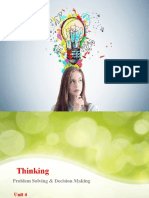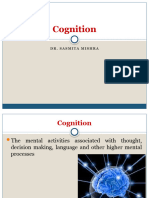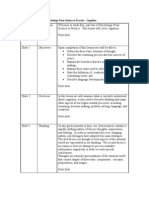0 ratings0% found this document useful (0 votes) 113 views12 pagesModule 1 - Cognitive Process
Psychology - Cognitive Process
Copyright
© © All Rights Reserved
We take content rights seriously. If you suspect this is your content,
claim it here.
Available Formats
Download as PDF or read online on Scribd
e ee
f PiNcuBation Depp
Cup
Guide
UNIVERSITY OF CALICUT
eoeilend menjoe1080e1
Re-accredited by NAAC with ‘A’ Grade
BSc PSYCHOLOGY
Semester 2
BASIC THEMES IN PSYCHOLOGY-II
Module 1: Cognitive Processes
www.pepponiine.in�NOoPpwNnep
Contents
. Thinking
. Reasoning
. Deductive and inductive reasoning
. Mental imaginary
. Problem solving
. Language
. Decision making�COGNITION
Cognition: The mental activities associated with thought, decision making, language, and other
higher mental processes
Cognitive ability: the skills involved in performing the tasks associated with perception,
learning, memory, understanding, awareness, reasoning, judgment, intuition, and language.
+ THINKING:
© cognitive behavior in which ideas, images, mental representations, or other hypothetical
elements of thought are experienced or manipulated.
© thinking includes imagining, remembering, problem solving, daydreaming, free
association, concept formation, and many other processes.
Basic units of thoughts
Our thoughts consist largely of three components: concepts, propositions, images
1. Concepts: are mental categories for objects, events, experiences, or ideas that are
similar to one another in one or more respects.
© They allow us to represent a great deal of information about diverse objects, events, or
ideas in a highly efficient manner.
© Concepts simplify the complex world of our experience which is full of diversities and
wide-ranging variations.
Types of concepts:
© Logical Concepts: Concepts that can be clearly defined by a set of rules or properties.
Natural Concepts: Concepts that are not based on a precise set of attributes or
properties, do not have clear-cut boundaries, and are often defined by prototypes.
2. Propositions: Sentences that relate one concept to another and can stand as separate
assertions.
3. Image: Mental pictures of the world�System 1 and System 2 thinking (Kahneman ‘s model)
Nobel Laureate Daniel Kahneman and describes the process of ‘thinking fast and slow”
otherwise known as System 1 and System 2 thinking. The intention of the theory was to provide
a helpful analogy that can guide our understanding of how our minds process information
‘System 1: -
© the brain’s fast, automatic, intuitive approach
© Includes the innate mental activities that we are born with, such as a preparedness to
perceive the world around us, recognize objects, orient attention, avoid losses - and fear
spiders!
Other mental activities become fast and automatic through prolonged practice.
System 2: -
© the mind’s slower, analytical mode, where reason dominates.
© activated when we do something that does not come naturally and requires some sort
of conscious mental exertion.
+ REASONING
Cognitive activity in which we transform information in order to reach specific conclusions.
formal reasoning and everyday reasoning
In formal reasoning;
© all the required information is supplied
the problem to be solved is straightforward
© there is typically only one correct answer
© the reasoning we apply follows a specific method
In everyday reason;
© the kind of thinking we do in our daily lives: planning, making commitments,
evaluating arguments.
© is far more complex and far less definite than formal reasoning
© But because it is the kind we usually perform; itis worthy of careful attention.
* Deductive and Inductive reasoning
Deductive reasoning: It isa logical approach going from general ideas to specific conclusions
It is a top-down approach.
Here, inferences are made by applying different premises.
(Premise is generally accepted idea, fact or rule)
Inductive reasoning: It starts with specific observations to draw general conclusions.
It is a bottom-up approach.
Basic sources of errors in reasoning
© Mood states: Individuals mood have an affect on their reasoning. Many of the
researches conducted on mood state and reasoning suggest that individuals with
negative mood performed worse than those with positive mood�© Belief: The belief bias is a cognitive bias that causes people to over-rely on preexisting
beliefs and knowledge when evaluating the conclusions of an argument, instead of
properly considering the argument’s content and structure, People often accept
arguments that align with their preexisting beliefs, even if those arguments are weak,
invalid, or unsound, and that people often reject arguments that contradict their
preexisting beliefs, even if those arguments are strong and logically sound.
© Confirmation bias: innate, unconscious tendency to interpret information in ways that
confirm what we already believe — or want to believe.
CONFIRMATION
BIAS
Hindsight bias: the tendency of people to overestimate their ability to have predicted an
outcome that could not possibly have been predicted. In essence, the hindsight bias is sort of
like saying "I knew it!" when an outcome (either expected or unexpected) occurs - and the
belief that one actually predicted it correctly.
Ex: you are nervous to take an exam for which you waited to study until the very last minute.
When you take the exam, you feel unsure about the results; however, when your grade comes
back a B+, you exclaim to your friends, "I was sure that I'd aced that exam!" and actually
believe it in hindsight.
« MENTAL IMAGERY
‘Mental imagery can be defined as pictures in the mind or a visual repre-sentation in the absence
of environ-mental input.
CONCEPTS
© A concept is simply a category or class of objects, events, qualities, or relations that
share one or more defining features.
© The defining feature allows us to discriminate between the members of one category
from the members of another category (or class).�WHEREVER YOU GO
YOU WILL SURELY
MEET A PEPPIAN
Fulfill your central university dream
with the |fSHSRGIHEIBESE coaching program in Kerala
Download
PEPP Learning App
For Admission Related Queries:
Call: +91 808925250, +91 8891359553
Visit: www.pepponiine.in�© Forming concepts helps us to make sense of the world and prepares us to anticipate or
predict future events more successfully. For example, classifying a predator in the
woods as a tiger prompts us to keep a safe distance
© Concepts also help us respond more quickly to events reducing the need for new
learning each time we encounter a familiar object or event.
Types of concepts
© Logical concepts: have clearly defined rules for determination of membership.
Eg: three sided form or figure - triangle
© Natural concepts: no or poorly defined rules.
Prototype
Mental representation that serves as a cognitive reference point for the category. The most
salient features of the prototype are the first features that come to mind when the category is
mentioned.
“ PROBLEM SOLVING
Problem solving is defined as the process in which people attempt to overcome difficulties.
‘The process involves achieving plans that move them from a starting situation to a desired goal
of reaching conclusions through the use of higher mental functions, such as reasoning and
creative thinking,
Types of problems
Well defined problem & Ill defined problems
1. A well-defined problem is one that has clarity in the problem, the problem solving
strategy, and the goal or solution.
2. On the other hand, an ill-defined problem (also known es a poorly-defined problem) is
cone where there is a lack of clarity, or in other words, abstractness or confusion, in
regards to the problem, problem solving strategy, and the goal or solution.
Routine problem and non routine problem
1. A routine problem is one that is typical and has a simple solution. Routine problems
are what most people do in school: memorizing simple facts, how to do addition and
subtraction, how to spell words, and so on
2. In contrast, a non-routine problem is more abstract or subjective and requires a
strategy to solve.Eg:the ethics of social issues such as the death penalty, or the role of
civil rights in laws, or themes in famous literature, might be considered non-routine
problems.
Problem solving strategies
A problem-solving strategy is a plan of action used to find a solution,
Common problem strategies include:
© Algorithms: algorithms are step-by-step strategies or processes for how to solve a
problem or achieve a goal.Eg:Instruction manual for installing new software on your
computer�© Heuristics: are general strategies used to make quick, short-cut solutions to problems
that sometimes lead to solutions but sometimes lead to errors. Heuristics are sometimes
referred to as mental short-cuts, and we often form them based on past experiences.
© Trial and error:Continue trying different solutions until problem is
solved.Eg:Restarting phone, turning off WiFi, turning off bluetooth in order to
determine why your phone is malfunctioning
© Abstraction — refers to solving the problem within a model of the situation before
applying it to reality.
© Analogy — is using a solution that solves a similar problem.
Brainstorming — refers to collecting and analyzing a large amount of solutions,
especially within a group of people, to combine the solutions and develop them until an
optimal solution is reached.
© Divide and conquer — breaking down large complex problems into smaller more
manageable problems.
Hypothesis testing — method used in experimentation where an assumption about what
would happen in response to manipulating an independent variable is made, and
analysis of the effects of the manipulation are made and compared to the original
hypothesis.
© Means-ends analysis — choosing and analyzing an action at a series of smaller steps to
move closer to the goal.
Barriers to problem solving
There are numerous obstacles to solving a problem. Generally, these
obstacles are mental constructs that impede the ability to correctly solve
problems. Some barriers do not prevent us from finding a solution, but do
prevent us from finding the most efficient solution,
Mental set:Mental set is the tendency to solve certain problems in the same way based
on how you have solved similar problems in the past. Mental set makes you blind to
any alternative approaches.
© Functional fixedness : Functional fixedness occurs when we only think about the most
common purpose of an abject (where you cannot perceive an object being used for
something other than what it was designed for).
“* LANGUAGE
Language is a communication system that involves using words and systematic rules to
organize those words to transmit information from one individual to another.
Structure of language
Five major components of structure of language:
© Phonemes
Morphemes
Lexemes
Syntax
Context�Phonemes: Phoneme is the basic unit of phonology. It is the smallest unit of sound that may
cause a change of meaning within a language, but that doesn't have meaning by itself.
Morphemes: Morphemes, the basic unit of morphology, are the smallest meaningful unit of
language. Thus, a morpheme is a series of phonemes that has a special meaning. If a morpheme
is altered in any way, the entire meaning of the word can be changed.
Lexemes: The set of inflected forms taken by a single word. For example, members of the
lexeme RUN include “run” (the uninflected form), “running” (inflected form), and “ran,” This
lexeme excludes “runner” (a derived term—it has a derivational morpheme attached).
Syntax: A set of rules for constructing full sentences out of words and phrases.
Context: How everything within language works together to convey a particular meaning.
Context includes tone of voice, body language, and the words being used.
Theories of language acquisition
© The behaviorist theory believes that “infants learn oral language from other human
role models through a process involving imitation, rewards, and practice. When a child
attempts oral language or imitates the sounds or speech patterns they are usually praised
and given affection for their efforts. Thus, praise and affection become the rewards.
© \Nativist theorists argue that children are born with an innate ability to organize laws
of language, which enables children to easily learn a native language. They believe that
children have language-specific abilities that assist them as they work towards
mastering a language.
© Interactionist approach (sociocultural theory) combines ideas from sociology and
biology to explain how language is developed. According to this theory, children learn
language out of a desire to communicate with the world around them. Language
emerges from, and is dependent upon, social interact MAKING
+ DECISION MAKING
The cognitive process of choosing between two or more alternatives, ranging from the
relatively clear cut (e.g., ordering a meal at a restaurant) to the complex (e.g., selecting a mate).
The act of evaluating (ie., forming opinions of) several alternatives and choosing the one most
likely to achieve one or more goals
Types of Heuristics
© Representativeness heuristic: involves making a decision by comparing the present
situation to the most representative mental prototype.
© Availability heuristic: is a cognitive bias in which you make a decision based on an
example, information, or recent experience that is readily available to you, even though
it may not be the best example to inform your decision.For example, plane crashes can
make people afraid of flying. However, the likelihood of dying in a car accident is far
higher than dying as a passenger on an airplane,
© Familiarity heuristics: The familiarity heuristic uses familiarity to help you decide
between a range of choices. This heuristic assumes thet the person, thing or situation
you know will always remain or behave as you remember it. Your familiarity with it�makes you consider it the safest option among other choices with which you have less
experience or knowledge.eg: choosing a brand of noodles, while you are purchasing,
which you had the best previous experience
© Anchoring heuristics: occurs when you rely heavily on either pre-existing
information or the first piece of information (the anchor) when making a decision.
+ CREATIVITY
Creativity involves the ability to develop new ideas or utilize objects or information in novel
ways.
Primary components of creativity
Originality: The idea should be something new that is not simply an extension of something
else that already exists.
Functionality: The idea needs to actually work or possess some degree of usefulness.
Stages of creativity
1. Preparation: the thinker formulates the problem and collects the facts and materials
considered necessary for finding new solutions
2. Incubation: The overt activity and sometimes even thinking about the problem is
absent in this stage. But the unconscious thought process involved in creative thinking
is at work during this period. Apparently, the thinker will be busy in other activities like
reading literature or playing games, etc. Inspite of these activities the contemplation
about finding a solution to problem will be going on in the mind.
3. Illumination: clusive “aha” moment. After a period of incubation, insights arise from
the deeper layers of the mind and break through to conscious awareness, often in a
dramatic way. It’s the sudden Eureka! that comes when you’re in the shower, taking a
walk, or occupied with something completely unrelated. Seemingly out of nowhere, the
solution presents itself.
4. Verification: Following the aha moment, the words get written down, the vision is
committed to paint or clay, the business plan is developed. Whatever ideas and insights
arose in stage 3 are fleshed out and developed
Pettey] Ce ae CoC�fe age) eases
Premier Entrance
Preparation Program
74-l] JOIN
PEPP GUIDE
El WHATSAPP GROUP
SUBSCRIBE
PEPP YOUTUBE
CHANNEL
Download
PEPP Learning App
Fulfill your central university dream
with the!
coaching program in Kerala
For Admission Related Queries:
Call: +91 808925250, +91 8891359553
Visit: www.pepponiine.in�IF YOU HAVE A DREAM
YOU’RE
rN |
SIU UB ole metal tc MCLANE NYAS XL
Widen al=)
coaching program in Kerala
P2) Download PEPP Learning App
EU katy
ce
ASTER

























































